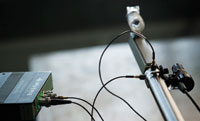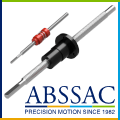
Posted to News on 16th Jun 2016, 00:00
Calibration system improves olympic shooters" accuracy
French engineering student Raphaël Chevalier has developed a device that helps Olympic prone shooters improve their accuracy by up to 24%. Prone position is the most basic and stable of all rifle shooting positions. Trained shooters often master the prone position first, as it is the one position where all common shooting factors can be isolated and addressed.

The 50-metre rifle prone shooting event, also called ‘60 shots’, has been part of the Olympic Games since 1908. In this event, competitors shoot from a distance of 50 metres with a .22 long rifle carbine at a target 15 centimetres in diameter. The goal is to shoot all 60 shots as accurately as possible within the 50-minute time limit. In 2013, Raphaël met Olympic shooter Rémi Moreno Flores. Rémi is a PhD in Sports Science specializing in carbine shooting performance. With so much in common, the two became friends and Rémi introduced Raphaël to the rest of the Olympic team.
Rifle shooting is a precise science where the combination of barrel and ammunition affects the bullet’s accuracy. This is mainly due to the gun’s ‘kick’, also known as recoil, as the bullet fires: transverse vibrations result from recoil forces in the rifle imparting on the back of the barrel. These vibrations cause a variation in shot accuracy.
Raphaël soon got the idea to develop a system and corresponding technique for analysing and predicting how rifles perform with certain ammunition. He explains: “Traditionally shooters experiment with endless combinations of ammunition and barrel in an attempt to minimise the effect of the vibration. It’s a lot of trial and error and it’s very time-consuming. You can even be eliminated from a competition if you are using the wrong ammunition. I got the idea to measure the vibration of the rifle to help minimise the trial and error process. With my system, the Olympic team can fine-tune their gear during training in order to improve their performance during competition.” Once Raphaël had his methodology in place, he needed some help testing the system, gathering data and analyzing the results, so he contacted Brüel & Kjær. “When I explained my research project to them, they responded enthusiastically,” says Raphaël. “They sent Henri Gérenton, who is an application engineer, to meet with us at INSEP (France’s National Institute of Sport and Physical Education) and do a half-day measurement session.”
Henri comments: “I was very impressed with the level of research this young group was conducting. We had Raphaël and Rémi, two clearly very clever and passionate people, along with other international-level shooters and their national trainer, Éric Viller. As a group, they had very keen expertise in this niche domain, and they were conducting top-level research with a good methodology. It was exciting to be a part of it.”
To capture the data they needed, Henri and Raphaël placed two accelerometers – one vertically and one horizontally – at the extremity of the gun barrel, and they recorded time signals of the shots in order to reconstruct the motion of the muzzle and the muzzle jump (the tendency of the front end of the firearm to rise up after firing).
Henri and Raphaël recorded signals using Brüel & Kjær LAN-XI data acquisition hardware and PULSE Time Data Recorder software. They made as many recordings as possible in order to increase their statistics, and they changed parameters, such as the gun barrel, the ammunition, the gun itself and the specification of the gun barrel, in a systematic way to achieve a more nuanced view of their results.
“Thanks to the measurements done by Brüel & Kjær, we have been able to determine the relative impact of some of the parameters on vibration and confirm the efficacy of different types of rifles and gear,” explains Raphaël. “That means we were able to calibrate my system for optimising the barrel-to-ammunition match that will improve shooters’ gear accuracy during training.”
Raphaël also gathered data for developing a tool for measuring muzzle jump. This tool can help shooters and their coaches better analyse their shots during competitions. Although in experimental stages, the system is already being used to fine-tune rifles for shooters training to qualify for the 2016 Olympic Games.
“It’s so exciting to be a part of the Olympic training process – and really gratifying to see what impact my research and tools are having on the shooters’ results,” says Raphaël. “At the last training session I attended, the trainers saw a 24% improvement in accuracy thanks to my tools. I can’t wait to see the results of the Olympics this summer.”
















